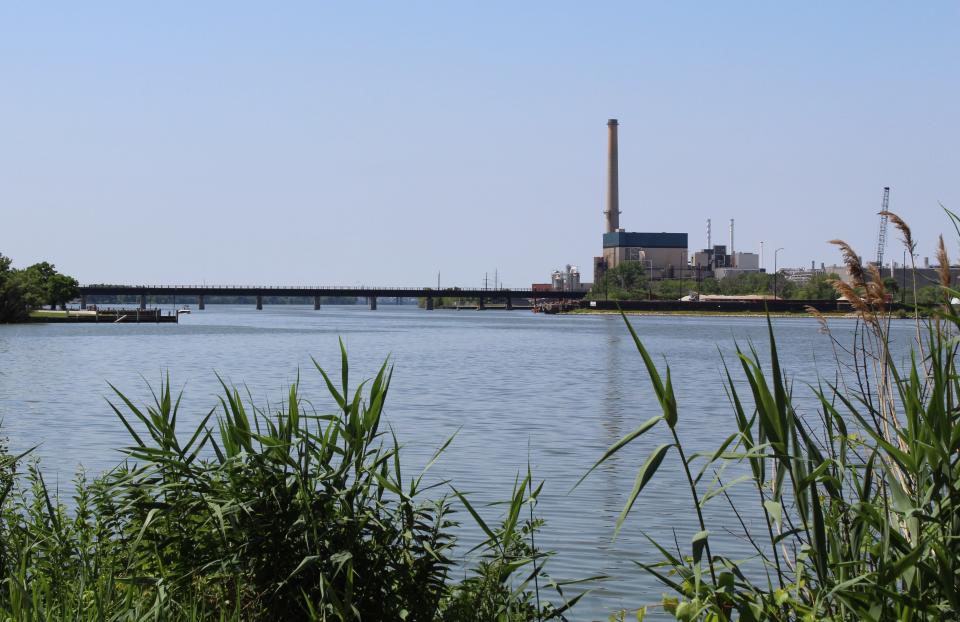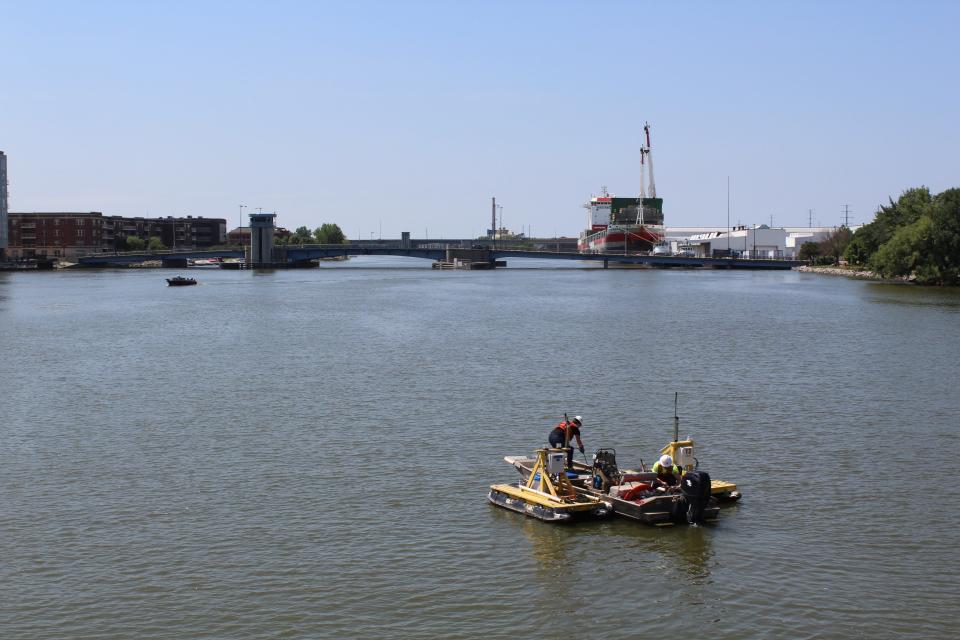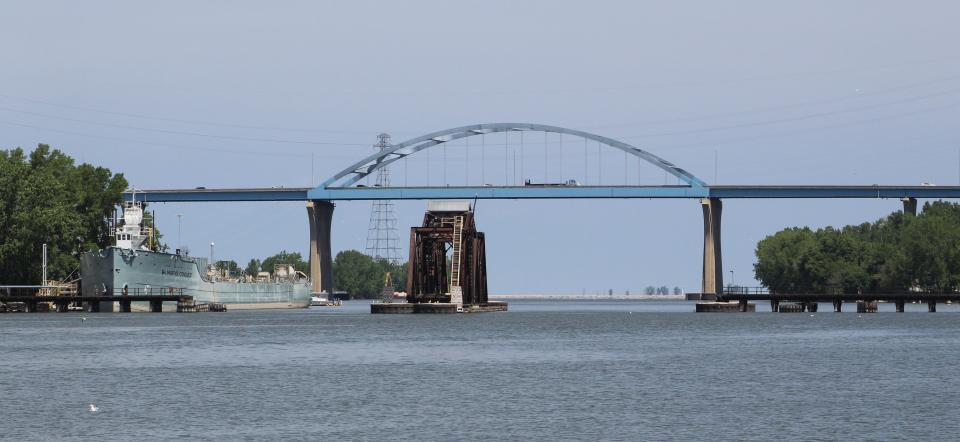Authors of new book revisit epic battles to clean up PCBs from the Lower Fox River
When Susan Campbell first moved to Green Bay from Philadelphia in 1993 she had her eyes set on living near the water. Those thoughts subsided after one apartment manager warned her that no one wanted to live near the water. It was too polluted.
As the new environment reporter at the Green Bay Press-Gazette, Campbell knew she’d be telling stories about pollution, but it wouldn’t be about the fumes billowing from the smokestacks or the smell of sulfur that lingered in the air. She’d be reporting on an odorless, invisible pollutant lurking beneath the water.
The Lower Fox River that flows into the bay of Green Bay was one of the many places throughout the Great Lakes polluted with polychlorinated biphenyls. PCBs are a class of hundreds of chemicals banned in 1979 because of harmful effects to humans and the environment.
Along the Fox River, paper companies started manufacturing carbonless paper coated with PCBs in the 1950s. PCBs bind to dirt, so they settled into the riverbed, wreaking havoc on local bird and fish populations.
The dredging project to remove PCBs from the sediment was completed in 2020, but it was a long road to get there. In "Paper Valley," published last month, David Allen, a former government scientist, and Campbell examine the battles behind one of the largest, most divisive PCB river cleanups in history, paid for entirely by the paper companies. The cleanup totaled $1.3 billion dollars and removed 6.5 million cubic yards of contaminated sediment.
Allen and Campbell talk about what it was like to write the book; the conversation was edited for brevity and clarity.

More: Challenges remain in Fox River, despite $1.3 billion removal of 3.5 million tons of toxic sediment
Why are PCBs so bad for the environment?
David Allen: First of all, they’re persistent so they don't break down easily. On top of that, PCBs don't like to dissolve in water. They like to dissolve in fats and oils. And then third, it's toxic at really low levels. PCBs are a whole class of chemicals. And these 209 different individual chemicals all behave differently in the environment and in organisms. It makes it really complicated to figure out what's happening. And then finally, they're so hard to get rid of.
Susan Campbell: These PCBs had been moving for years into the bay of Green Bay and the Great Lakes and beyond. The Fox River was basically a spigot of these highly toxic chemicals. There were subsistence fishermen, particularly among the Hmong population there that were eating a steady diet of fish that were contaminated with PCBs.
The book mentions that this was the 'world’s largest, most divisive, most politically charged environmental river cleanup of its kind.' Why?
Allen: First of all, the size. The fact that the Superfund settlement at $1.3 billion dwarfs most Superfund cleanup settlements anywhere in the country, even big, famous ones like Hudson River. Furthermore, the amount that's been cleaned up here, 6.5 million cubic yards of sediment dwarfs anything that's ever been accomplished anywhere other than navigational dredging.
Campbell: There were a lot of environmental activists who wanted the river clean. They wanted the river that ran through their city to be safe and the fish coming out of it to be safe. And then there were a lot of people who were concerned about paper mill workers. There was a lot of concern that the cleanup of that magnitude … would bankrupt the paper companies, and they were the backbone of the Fox River Valley.
As a scientist and a journalist, respectively, you were looking at this from different perspectives. What was the biggest challenge?
Allen: I'm a wildlife biologist, so I'm not an expert in all these different fields that you need. When the case really started to gain momentum, I had to figure out how I was going to inform the public in a way that would influence the politicians.
Campbell: I didn't have a science background. Trying to understand the science of PCBs and the different regulatory environments of the state and the federal agencies and how they came together. Understanding the paper company's perspective and then trying to tell the story to the public so that they would understand and care.
More: Milwaukee is turning around one of the most degraded sites in the Great Lakes. Here's how.

What was it like to revisit these issues?
Allen: This all started at a big reunion for the people that worked on the damage assessment for this case in 2016. A couple of my colleagues called me up and were distressed. They said: "Nobody even remembers what we went through to get this case launched." They convinced me that someone had to write this down and tell the story that everyone seemed to maybe forget. And it was shocking even to me when I went back to my notes, just how intense the fighting was. I've worked in 25 states and on many other cases like this, and there's never been another place I've seen this kind of warfare between agencies fomented by the paper companies.
Campbell: I wrote hundreds of articles during that time, and there was so much scrutiny and investment from the scientists, environmental community, state and the federal agencies and the public. This was a real epic story in a lot of ways, and a lot of good has come out of it. Going back and revisiting the story and reading a lot of the stories that I'd written was like binge-watching a series.
What went through your mind when you first heard the river was declared cleaned up?
Allen: A deep sense of satisfaction. But then second, and why I ended up staying motivated about the book, is I wanted to find a way to help other people do the same thing.
Campbell: There was a little bit of incredulity and amazement that it actually happened. And I'm really, really pleased for the people who live up there and are enjoying the water.

More: 'Still a lot more to do' as Evers, environmental leaders announce end of Fox River dredging project
How can the story of the Fox River cleanup help other environmental challenges across the Great Lakes?
Allen: If you look at the facts and the law, and you keep transparency there, the public can overwhelm political obstacles. The public and the scientific community can hold everybody accountable. This applies beyond cleanup whether you're looking at PFAS issues, nonpoint source pollution, climate change or election results.
Campbell: I think the lesson here is that if you have the right people wielding the right laws and an open minded public that's engaged and paying attention, these seemingly intractable environmental problems can be addressed.
Caitlin Looby is a Report for America corps member who writes about the environment and the Great Lakes. Reach her at clooby@gannett.com or follow her on Twitter @caitlooby.
Please consider supporting journalism that informs our democracy with a tax-deductible gift to this reporting effort at jsonline.com/RFA or by check made out to The GroundTruth Project with subject line Report for America Milwaukee Journal Sentinel Campaign. Address: The GroundTruth Project, Lockbox Services, 9450 SW Gemini Dr, PMB 46837, Beaverton, Oregon 97008-7105.
This article originally appeared on Milwaukee Journal Sentinel: Authors revisit battles over massive PCB cleanup of Lower Fox River

